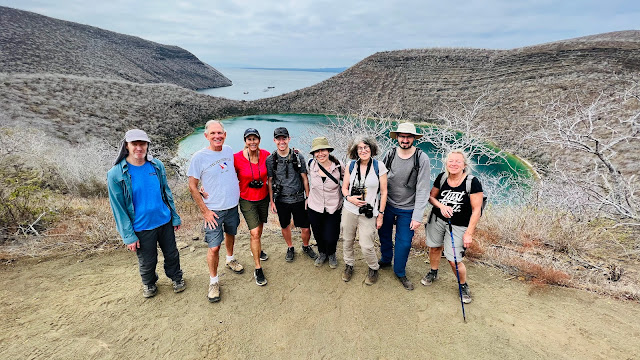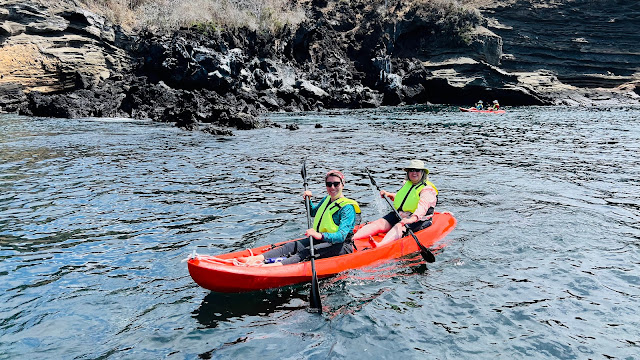A boatful of Shellbacks
 |
| Photo: Sandie Young |
 |
| Photo: Omar Medina |
At the top of our trail was a lookout over the volcanoes, including Darwin and Wolf, and further islands in the distance to the east. Feeling inspired to return for longer to these islands, I asked about how research teams get projects going in Galápagos. One can dream - time for a PhD?
 |
| Photo: Sandie Young |
The kayaks were strung along the side of the boat ready for us. Sue and I teamed up, clambouring in over the side of the dinghy with as much grace as possible. Her husband, Paul, somewhat apprehensive of sitting on top of the ocean like this, decided it was best for their marriage if they split up for this particular adventure. Our five red kayaks paddled and drifted along the side of the cliff face where Noddy Terns and Blue-footed Boobies make their lives on tiny perches, eyeing us with curiosity, keeping track of passing fish and potential lunch. Penguins and cormorants dove noiselessly, and sea lions played alongside. Watching wildlife throughout the islands, I’m struck by how peacefully all these species coexist. There are very few predator-prey interactions overall, with many of these larger species leaving each other well-enough alone while living on top of each other.
 |
| Photo: Omar Medina |
Over lunch the boat cruised along to Vincente Cove as we got ready for snorkelling. The water was colder than ever and I was shivering immediately. Much of my action cam footage is not very steady here! But it was so worth it; there must have been dozens of sea turtles. I’d be intently watching one bob and feed, and turn around to see another two had snuck up behind me. There were great schools of fish, sea lions diving beside us, little reef sharks at the bottom, all along the dramatic cliff face of a sloughed volcano. Again, I watched a cormorant fishing beside me. We travelled into a cave, and explored the shallow shoals in the most treacherous-looking places, but under the water it was blue, clear, and calm, sunlight filtering in with bands of broken gold. When I was shivering uncontrollably, I raced back to the dinghy. My skin was blue and it was a chilly ride back before racing up to the jacuzzi to warm up before a very hot shower.
No time to rest on an action pack day, and we hopped in the dinghy for a cruise. We rode past the cliffs where we’d just been swimming and talked geology. There were thick bands of dark rock where lava had slipped through, and dark black rock overlain with dusty yellow - the same material deposited in different methods, with the black oozing out versus being expelled more violently. We rode through that deep dark cave, playing with silhouettes at the wide mouth.
 |
| Photo: Omar Medina |
The Reina Silvia travelled ever northward, battling the rough waves. A golden sky illuminated the western coast of Isabela, casting an ethereal glow on Volcánes Ecuador and Wolf. With violent waves tossing the sizable catamaran port to starboard and the promise of a fun equator crossing at sunset, there was an atmosphere of ecstasy on board buoyed by the power of the ocean. Stumbling up to the top deck, where the effects of the rocking ship were most noticeable, I suddenly realised that this is among the happiest I have ever felt in my life.
 |
| The Captain's View. Photo: Graham Black |
As we approached the equator, we were called to the Bridge to watch Captain Luna in action and see the latitude hit 0 degrees. Omar explained the navigation system to us as el Capitán calmly steered on through crashing waves. Michael and Barbara emerged as King and Queen Neptune, guardians of the sea in their robes, blue bed sashes, tinfoil crowns, and trident to perform the Shellback Ceremony for all us pollywogs. An ancient mariner’s tradition, first-time equator crossers go through a hazing of sorts to mark the occasion. We playfully crossed the representative equatorial towel and received our Shellback Certificates from King Neptune himself. Upon returning home, I have since framed my certificate, which brings me right back to this moment of pure joy. I will treasure it and am very grateful to Michael and Barbara for making this event memorable and remarkable.
 |
| Photo: Sandie Young |
Still filled with this child-like joy, we toasted St. Andrew’s Day for our Scottish friend and had a robed dinner with King and Queen Neptune before buckling in for our roughest sea crossing as we continued north. After attempting to watch The Galápagos Affair, which Omar had kindly loaded up on all our TVs, it was time to admit defeat, take a Gravol, and hope for the best. The waves were crashing against the hull as the boat lurched front to back, sounding like the Reina Silvia might rip clean in two or scrape against the bottom of the Pacific Ocean.



















Comments
Post a Comment